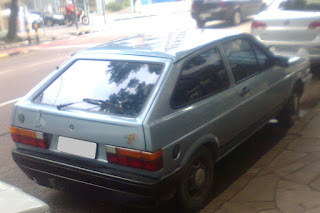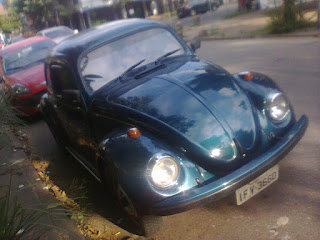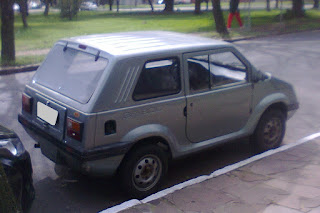Gol 1000: despite having already gone through a few facelifts, the bodyshell was basically the same released in '80 when the Gol still relied on the air-cooled boxer engine, now front-mounted and driving the front wheels, in a 1.3L version. Later the 1.6L boxer had been offered, but the Gol would only become a major player in the Brazilian automotive market once it switched to liquid-cooled engines. During the AutoLatina joint-venture by Volkswagen and Ford in Brazil and Argentina, Ford sourced its Renault-designed CHT engine for Volkswagen to use in entry-level versions of the Gol and its derivatives in exchange for the EA827 to be fitted to the Escort and some Brazilian derivatives of the Renault 12 project taken over by Ford's local branch after merging with Willys-Overland which was Renault's partner for the Brazilian market until '67. In the end, this meant Volkswagen would use a Renault-designed engine for its earlier 1.0L version of the Gol.
Even though it was already outdated by then, the hatchback provided an easier access to the luggage compartment compared to the classic Beetle with its tiny front luggage compartment under the front bonnet and that internal one between the rear seat and the firewall which was only accessible from the inside.
Despite this practical disadvantage, the Beetle was reintroduced to the Brazilian market in '93 after a 7-year hiatus started in '86. Even though it was supposed to not benefit from the same tax break that favored engines with a displacement equal to or below 1.0L or 61 cubic inches, the rule was amended by then-president Itamar Franco to allow air-cooled engines up to 1.6L to also be included in the fiscal benefit. Brazilian Beetles made during this brief '93-'96 reintroduction were soon nicknamed "Fusca Itamar", refering to the personal request of the president for Volkswagen to relaunch the model. Sure its cross-country capabilities, matched only by vehicles with a much higher price tag, were a valuable asset in a country where most roads are still unpaved, but the higher degree of automation on the production of newer cars and some changes on customers' preferences meant the Beetle was not so appealing to the general public anymore.
Sunday, August 26, 2018
Saturday, August 25, 2018
Gurgel BR-800, the Brazilian subcompact that nearly became an effective replacement for the Volkswagen Beetle
With the first production-ready prototypes featured in Brasília during the Independence Day Military Parade in september 7th, 1987, and the deliveries starting in the following year, the Gurgel BR-800 was not so much of a commercial success but had some technical features that rendered it effective as a viable replacement for the Beetle. Despite having a front-mounted engine while retaining the rear-wheel drive, which called for a presumably less-efficient transmission setup due to the presence of a driveshaft, the 50-50 unloaded weight bias meant any compromise to the the cross-country capability would be minimal. Relying on the same 4-speed manual transmission and rear axle found in the 1.4L versions of the Chevette, the Gurgel-designed 0.8L water-cooled OHV flat-twin was meant to reach the then-impressive 25km/l (around 62MPG) fuel consumption. Overall performance was not really something to brag about, but neither were some comparable European-designed cars that were never brought to Brazil by the local branches of foreign automakers such as Fiat. Featurng a space-frame chassis with a fiberglass-reinforced plastic body, its manufacturing was somewhat labor-intensive and time-consuming in a comparison to the pressed-steel unibody layout which was already widespread among major automakers.
Marketing was not so great, with the sales between 1988 and 1990 being tied to stockholding of the company and therefore it became a less attractive option for those buyers who were just looking for a no-frills car and nothing else. The situation became worse for Gurgel in 1990 when Fiat applied for a fiscal incentive for cars up to 1.0L instead of 0.8L and the Fiat Uno Mille could be offered at a more competitive price due to the greater production scale inherent to its design. As a former director of the local branch of Mercedes-Benz once said, Brazilian people consider the size of a car as one of the most relevant matters comparing different models close in price, so the 3.195-metre long and 1.47-metre wide BR-800 was in a clear disadvantage against the Fiat Uno, being phased out in 1991 with a technically-similar model named Supermini replacing it from 1992 to 1994 when Gurgel went out of business. However, nowadays with a new generation of small city-cars flourishing even in Brazil, it's worth to remind the Gurgel BR-800 and the attempt to effectively replace the Volkswagen Beetle.
Subscribe to:
Comments (Atom)





